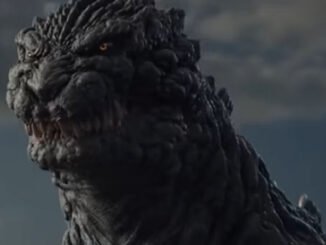 When first released in the United States in 1957, the Japanese monster film Godzilla found itself trimmed of 40 minutes of footage, with a new twenty minutes added featuring actor Raymond Burr, and much of its intended subtext missing as well. Now nearly 50 years after the film’s original Japanese premiere, Godzilla is finally able to be seen in the United States as it was originally intended by its creators.
When first released in the United States in 1957, the Japanese monster film Godzilla found itself trimmed of 40 minutes of footage, with a new twenty minutes added featuring actor Raymond Burr, and much of its intended subtext missing as well. Now nearly 50 years after the film’s original Japanese premiere, Godzilla is finally able to be seen in the United States as it was originally intended by its creators.
When several fishing boats are mysteriously destroyed the military seems to be unable to supply an explanation. However, the cause reveals itself soon enough. It is 150 foot tall prehistoric creature which Professor Yamane (Takashi Shimura, who would go on to appear in Akira Kurosawa’s Hidden Fortress (1958) and Yojimbo (1961)) hypothesizes has been displaced from its native underwater habitat by H-Bomb testing. Named Godzilla after an old fishermen’s legend about a deep-sea demon, the creature goes on a rampage across the country with military finding itself unable to stop it. However, Yamane’s daughter Emiko’s fiancée Dr. Serizawa (Akihiko Hirata) has developed a weapon known as the Oxygen Destroyer, which could bring an end to Godzilla’s destruction. However Serizawa is afraid that revealing his weapon to the world will only escalate the arms race among the countries of the world.
The public’s perception of Godzilla is mostly colored by the series later entries that often featured the monster squaring off against some other mutated beast in a fight that levels cities. But the original 1954 version is far darker than the Saturday afternoon matinee material the series would evolve into. Inspired by the national uproar following an incident in which fallout from a Bikini atoll atomic test rained down on a Japanese fishing boat, Toho Pictures producer Tomoyuki Tanaka conceived of a film featuring a radiation spawned monster that would embody the horror of nuclear war. But as the cautionary tale was developed with director Ishiro Honda, Godzilla soon grew to encompass all war. A shot of the Tokyo skyline burning recalls the fire bombing of Japan during World War II. As Godzilla approaches a mother cradles her young children saying “Soon we’ll be with Daddy.” Scenes of hospitals and make shift triage centers are filled with people suffering from radiation burns and children crying over lost parents recall the aftermath of the atomic bombings of Hiroshima and Nagasaki. While some of the special effects work is undeniably low tech, these scenes are still powerful to today’s audience. One can only imagine what feelings they stirred in 1954 Japanese audiences when such horrors were only a few years in their past. Such a powerful anti-war subtext ranks this film right next to Robert Wise’s The Day The Earth Stood Still (1951) as one of the most important genre films of the decade.
The human element is not overlooked. The love triangle between Serizawa, Emiko (Momoko Kochi) and the man she really loves Naval officer Ogata (Akira Takarada) is more developed in this version and forms the emotional center of the film, giving a human drama to play out against the backdrop of Godzilla’s devastation. Although played fairly understated, it’s still strong enough to fuel the emotional component of the film’s finale. But it is Yamane who provides the film’s moral core when, in a line trimmed from the original American release, he warns that the horror of Godzilla, and what he represents, has not be totally vanquished. “Another Godzilla will appear, somewhere in the world.”




